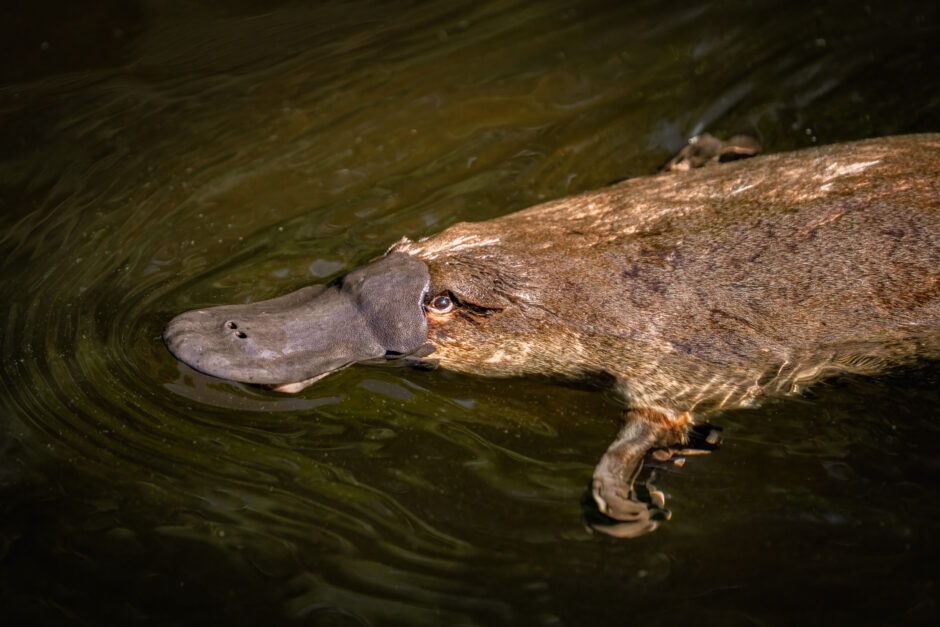
How I Got this Shot- Platypus Close-Up in Tasmania
Let’s start with the obvious: photographing a platypus is a ridiculous pursuit. You’re chasing a creature that looks like it was designed by a committee of drunk zoologists; duck bill, beaver tail, otter body, venomous ankle spurs. Add the fact that it’s shy, tiny, and mostly underwater, and you’ve got one of the hardest wildlife portraits in Australia. Which, of course, makes it irresistible.
So how do you get close enough for a clean head shot of one of nature’s most unique animals?
Know Your Opponent
Platypuses live life on a stopwatch. When they dive, they close their eyes and ears, which means you can stand up, shift your position, even talk to your buddy without blowing it. But the second they surface, the rules change. Suddenly their senses are wide open, and the tiniest movement or sound will send them vanishing like a kid who know’s they’re in trouble. The key: move when they’re under, freeze into statue mode when they’re up. Which to be honest is a blast; when else as a wildlife photographer can you play freeze tag?
They also dive like maniacs. Most dives are under a minute, and when they’re foraging, they repeat this routine up to 75 times an hour. That’s good news for photographers. Even if you blow the first twenty tries, you’re still going to get more chances. Think of it as the world’s cutest slot machine: keep pulling the lever and eventually you’ll win. The trick is that slot machine reappears in a different part of the casino after every pull.
Gear and Settings
For this shot I went big: 500mm on my 200–600mm lens. The platypus is small, and unless you feel like wading into a cold Tasmanian creek, long glass is your friend. I locked in 1/2000 sec to freeze the quick twitch of its bill and any ripple of water, and with a sunny day on my side, ISO 800 kept things clean.
The real trick, though, was focus. I used single-point autofocus and aimed for the eye. Why? Because when a platypus pops up from a dive, it surfaces wearing a thin layer of water like a wet glaze. That sheen hangs there for a second before it drains off, and it’s a surefire way to trip up your autofocus system if you’re not dialed in tight. Nail the eye through that watery veil, and suddenly you’ve got a tack-sharp portrait of one of Earth’s strangest animals.
Fieldcraft (a Fancy Word for Sitting Still)
Forget camouflage nets or expensive blinds. The best tool you have for platypus photography is your ability to sit still. I wedged myself low on the creek bank, sat on some rocks, and tried not to fidget. Each time the animal surfaced, I froze solid, clicking off frames while silently begging it not to notice me. It felt less like wildlife photography and more like a weird game of red light/green light.
Wrapping It All Together
Photographing a platypus feels less like checking a box and more like stumbling into a childhood daydream. This is an animal you grow up seeing in the pages of science books, not one you expect to watch paddling by in a run-of-the-mill creek. The moment you finally get a solid frame; you can’t help but laugh at the absurdity and the privilege of it all. It’s part photography, part adventure, and mostly the joy of realizing that sometimes the legends of the animal world are real, and you can venture to put them right in front of your lens.
Want to put your own patience to the test? Head to southern Australia where Tasmania gives you front-row seats to platypuses in their home streams, plus wombats, parrots, wallabies, and skies dark enough for astrophotography. You’ll learn quickly: you don’t need a zoo of gear, just a little stealth and the nerve to hold still when it matters.
Leave a reply